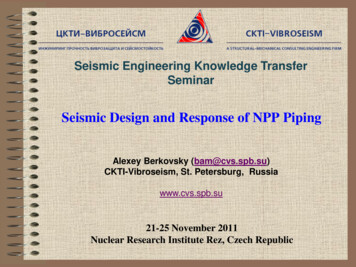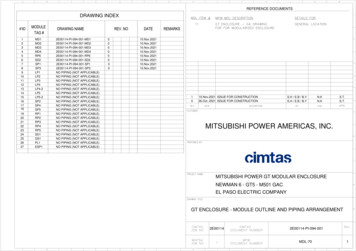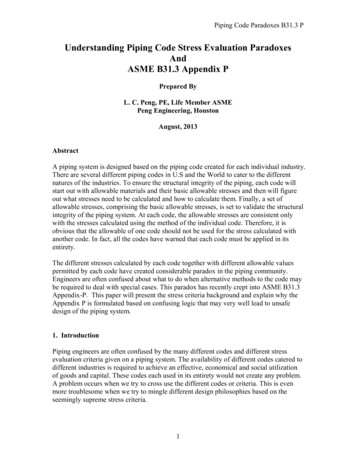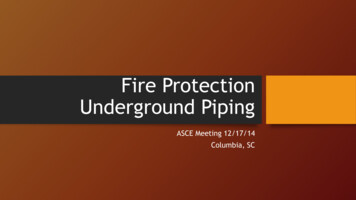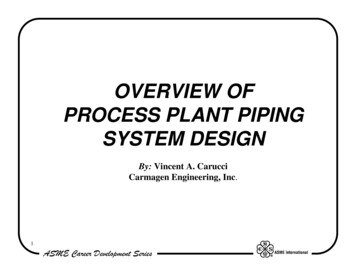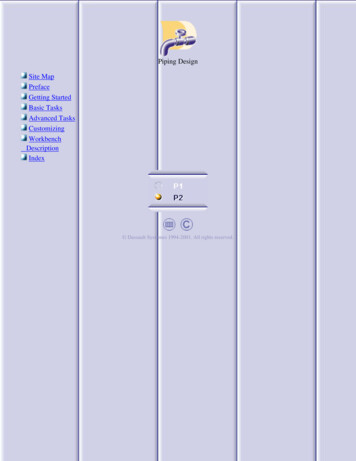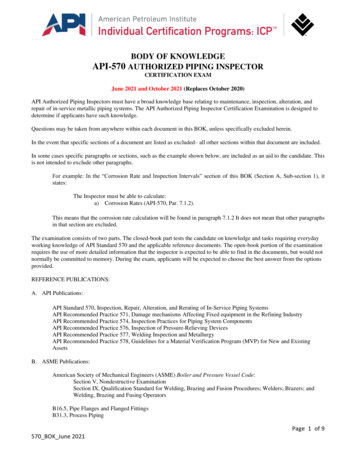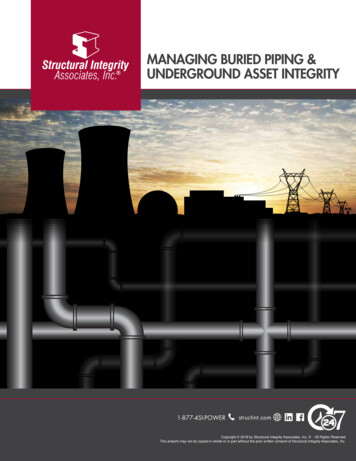
Transcription
MANAGING BURIED PIPING &UNDERGROUND ASSET INTEGRITY1-877-4SI-POWERstructint.comCopyright 2018 by Structural Integrity Associates, Inc. - All Rights ReservedThis artwork may not be copied in whole or in part without the prior written consent of Structural Integrity Associates, Inc.
MANAGING BURIED PIPING ANDUNDERGROUND ASSET INTEGRITYBEvaluating and managing the integrity of buried piping and otherunderground Systems, Structures, and Components, especially thosethat contain radionuclides, in the nuclear industry is a challengingissue that requires multiple skill sets to properly handle.The processes and practices involve specializedING & INSPECTANKI ONskills as part of an overall asset life cycleRSKPLmanagement approach. StructuralIRANEIntegrity Associates, Inc. (SI) hasNNIINLestablished and proven techniquesEGSfor the successful ranking,Ainspection and mitigation ofdegradation of buried andunderground assets thatcan lead to improvedplant safety andreliability.EMENTNAGMATSESATION & NDE2 MANAGING BURIED PIPING AND UNDERGROUND ASSET INTEGRITYPECINS(InTellus,Soil, etc)Structural Integrityis unique in theindustry in its offerof an integrated,multi-disciplinaryapproach to buriedand undergroundcorrosion concerns.We can assemblea multi-disciplinaryteam quickly toaddress virtually allcorrosion issues. SIhas the comprehensiveexpertise to assist inall phases of aboveground piping, buriedpiping and undergroundasset integrity programs fromprogram development, dataintegration and risk ranking, toNTconducting assessments of cathodicEMprotection (CP) systems to using GuidedSSESWave Technology and Linear Phased ArrayS CONDITION Ato locate and characterize corrosion damage.Once the foundation has been established,knowing how to disposition those findings and mitigatefuture degradation is critical. Integrating all available information(i.e., design, soil, groundwater, CP system operation, plant history,etc.) will lead to informed decision making and improved processmanagement while shifting the focus from costly remediation to aproactive prevention plan.
Risk Ranking BPWorks Database MAPPro Risk Probabilistic Leak EvaluationInspection Planning Threat Assessment Criteria Development Acceptance Criteria Technique Selection Effectiveness Optimization SchedulingIndirect Inspection InTellus – Coating Condition & Cathodic Protection(CP) System Effectiveness Survey CP System Design and Repair SoilPro – Site Selection, Soil Corrosivity Analysis,Corrosion Rate Calculations Guided Wave TestingDirect Inspection Bell Hole Inspections (coating, CP, UT) Ultrasonic Wall Thickness Testing Electromagnetic Acoustic Transducer (EMAT) Testing Linear Phased Array UT and TOFD PT, MT, radiographyCondition Report Evaluation Support (Int/Ext corrosion modeling) Data Integration Fitness for Service Extent of Condition Analysis Life Cycle Management AssessmentsCONDITION ASSESSMENTASSET MANAGEMENT PLANData Collection EPRI BPWorks Database Population MAPProView - Component Digitizing & Data Visualization 3-D Component Modeling Ground Water Monitoring WellsTSU FOSSIL NDEDisposition Code Case N-513-3, N-597-1 Calculations Pre-Inspection Flaw Handbook Reinspection Interval Calculations Fracture Mechanics & Finite Element AnalysisCause Analysis Metallurgical Failure Analysis Apparent/Root Cause AnalysisRemediation Repair Plan and Procedures Remediation Plan Development 3rd Party Design & Procedure ReviewMitigation Cathodic Protection System Design or Repair Coating Reconditioning: Selection / Design Materials Engineering: Selection / Design Groundwater (NEI 07-07) Program IntegrationMonitoring Installation & Testing Services Cathodic Protection Test Stations and Wells Permanently Installed Guided Wave Collars Permanent CP Half-cells Corrosion Coupons (Internal & External) BIoGEORGE Analysis Trending Corrosion Monitoring & Data Mining CP System Performance Ground Water Monitoring Wells Computational Fluid Dynamics Industry/Fleet Benchmark & Gap Analyses Assessment of Water Treatment ProgramsReinspection Interval Integrating Inspection Results, Soil Properties, CP,Coupons into Remaining Life EstimationsTRAININGBASELINE RISK RANKING & INSPECTION PLANNINGINSPECTION - REASONABLE ASSURANCEProgram Development Resources EPRI 1021175 (1016456, Rev1) EPRI 1016687 NEI 07-07 NEI 09-14 NUREG-1800 XI.M41 (GALL) Independent MAP Review of Existing ProgramsTraining MAPPro and BPWorks 2 training Program Management & Risk Management Corrosion Principles & Threat Assessment Cathodic Protection System Management Direct Inspections Flaw EvaluationsVisit our website G BURIED PIPING AND UNDERGROUND ASSET INTEGRITY 3
LEVERAGING BURIED ASSET DATAWITH INTEGRATED ENGINEERING ASSESSMENT APPLICATIONSNEI Initiative 09-14, Guideline for the Management of Underground Piping andTank Integrity, established formal goals and responsibilities driving the industry tomanage information about buried and underground pipe and tanks at nuclear plantsto minimize unexpected failures and their impact. Deadlines were established forrisk ranking buried pipe and ultimately conducting inspections on these systems toachieve reasonable assurance of structural and leak integrity. Structural Integrity hasbeen an instrumental contributor to the industry on this emerging issue.EPRI contracted with Structural Integrity in 2009 to develop the BPWorks 2.0database and software interface. This database provides the industry with a robustdata structure for storing and editing design, operating and inspection informationfor piping systems at a site.To complement BPWorks , Structural Integrity has developed the MAPPro familyof buried pipe applications. These engineering tools allow utilities to: Perform external and internal corrosion-based risk ranking of buried pipe, tanksand other structures not currently addressed in BPWorks risk algorithmsImport high volumes of data and evaluate the trends associated with cathodicprotection, soil testing, tritium monitoring wells and inspection data (e.g., GWT,BEM, UT, etc.)Visualize all BPWorks and MAPPro database information in an interactive,graphical GIS environment through our MAPProView tool.We havesuccessfully aligned ourspecialized engineering and pipeline corrosioncontrol experience to address buried pipe issues. A large portion of thedomestic nuclear fleet is using our corrosion engineering expertise and software tools for data discovery, risk ranking,inspection planning, inspection execution, excavation evaluation support, coating condition and cathodic protectionsystem evaluation (i.e., InTellus surveys), CP system design, flaw disposition, life cycle management studies, implementingcorrosion control monitoring, and re-inspection planning.4 LEVERAGING BURIED ASSET DATA WITH INTEGRATED ENGINEERING ASSESSMENT APPLICATIONS
1-877-4SI-POWERstructint.comMAPPro USER COMMUNITYStructural Integrity has created a MAPPro User Community to support thecontinued maintenance and development of user applications (aka MAPPro Apps). The benefits of this software support & maintenance agreement include 40hours of custom support/year, participation in the guidance and development ofnew tools, as well as free access to all tools as soon as they are developed.The current list of applications available or under development includes: MAPProView -- Structural Integrity’s data integration and visualization tool to allowsystem engineers to rapidly utilize database information, overlaid onto plant drawingsor aerial imagery in either 2D or 3D. Photographs, as well as PDF and DWG files canbe linked into this system for instant viewing. (pg. 7)MAPPro Risk – Addresses all pipe materials, fluid types, soil conditions, etc., andadjusts the risk model based on, but not limited to, corrosion mitigation (i.e. cathodicprotection) and inspection results. It also provides the ability to adjust the risk modelbased on unique plant conditions or operating experience. (pg. 8)MAPPro Tank – Addresses tanks, sumps and other buried structures. Data can bemanaged in this module and used in risk calculations. The risk results can be evaluatedalone or integrated with pipe risk results within the same system. (pg. 9)MAPPro GWT – Allows input and management of GWT inspection results such thatthey can be reviewed in BPWorks or MAPProView. (pg. 14)MAPPro CP – Imports Cathodic Protection measurements into BPWorks and performstrending analysis to expose issues. (pg. 11)MAPPro InTellus – Views and evaluates results from SI’s specialized coating conditionand CP system effectiveness inspection technology, InTellus. InTellus data is also viewablein MAPProView. (pg. 12)MAPPro LCM – Calculates and displays leak evolution curves as part of a quantitativeLife Cycle Management study. Probability and number of leaks can be plotted as afunction of time for a single component or for a system. (pg. 20)MAPPro Reports – Extracts and presents data from the BPWorks database. MAPPro Query – Search the BPWorks database based on custom needs. (pg. 10) MAPPro WellsMAPPro Inspection Planning – Identifies applicable NDE methodologies based oncharacteristics and can prioritize inspection dates based on risk ranking. Results can beexported or linked to plant site workflow management software. (pg. 16) MAPPro GWTMAPPro Cable – Manage information about low and medium voltage cables aspart of a Cable Aging Management program. Data can also be linked for viewing inMAPProView. (pg. 19)MAPPro N513 – Applies the principles of Code Case N-513to provide remainingwall thickness threshold guidance when performing excavations and UT inspection.Calculator can be used to generate preliminary flaw tolerance estimations in advance ofan inspection or excavation. (pg. 17)MAPPro Well – Stores measurement data collected at tritium monitoring wells andlists the nearest buried pipe to the well. Data also linked to MAPProView for visualizingresults as measured values change. (pg. 18)MAPPro 3DSoilPro – Models measured soil parameters into effective pitting corrosion ratemodels for use in remaining life and re-inspection interval determination. (pg. 21)MAPPro USER COMMUNITY 5
BPWorks 2.2 DATABASE SUPPORTWHY IMPLEMENT BPWorks The BPWorks database is the new industry standard for managing buried pipeinformation at a nuclear site. It is a robust database for storing information withthe potential to affect the internal or external corrosion potential of a buried orunderground pipe. The database has fields to record data about the design,operation, internal and external environments, historical performance, inspectionresults, cathodic protection measurements and other corrosion control information.BPWorksTMWHY USE STRUCTURAL INTEGRITY?Structural Integrity was the vendor hired by EPRI to develop the latest BPWorks database structure and interface. We understand the data structure and therelationship between data tables. We use corrosion engineers with experienceworking at nuclear plants to review records, interview system engineers as part ofthe data discovery process and populate the database. We also provide accessto a wide variety of additional engineering analysis tools (MAPPro Apps).CONVERTING LEGACY DATABASESStructural Integrity created the BPWorks 1.x to 2.x import tool that accompaniedthe BPWorks software product. SI can help implement a standard conversation,aggregate prior segmented data (for dynamic segmentation purposes), or assistwith acquiring supplemental data to enhance the value of risk ranking.SI has successfully mapped and imported data from non-BPWorks data sourcesinto BPWorks 2 – including the BPManager data structure as well as variousspreadsheet formats.DiameterWall ThicknessCoating TypeSoil TypeSegmented Pipeline6 BPWorks 2.2 DATABASE SUPPORTVISUALIZING BPWorks DATA IN MAPProView All data in the BPWorks and MAPPro database can be linked to MAPProView .MAPProView allows for unlimited site access to the data in a read only format.MAPProView files are easily viewable and don’t require software licensing.
1-877-4SI-POWERstructint.comMAPPro DATA VISUALIZATIONWHAT IS MAPProView?MAPProView stands for Managing Aging Piping Pro Viewer. MAPProViewis a core application in the MAPPro family of tools. This custom, easy-to-usedesktop mapping application, developed by Structural Integrity, links to the datafields in the BPWorks , MAPPro, and other database. This GIS (GraphicalInformation System) viewer is built on the ESRI ArcGIS application platform. Theviewer allows multiple users to view, explore, and print maps. ArcReader, a freeapplication, is required to view MAPProView.PMF files.MAPProView allows for unlimited site access to the data in a read only format.Synchronization to database changes is also available.VISUALIZING BPWorks DATA IN MAPProView 2D/3DAll data in the databases is linked to MAPProView 2D or 3D. To view dataand other information in MAPProView, plant piping, structures, roads, waterfeatures, etc. must be drawn (digitized) in a GIS environment. Plant drawings(yard, isometrics, details) that show pipe, tank, grounding grid, CP & monitoringwell locations, etc. are used in this process. Once these features are created,database information can be linked.MAPProViewA major advantage of GIS integration is that multi-variant data conditions canbe symbolized for representation or complex spatial analysis. Data attributescan change color, shape, style or size based on their value or condition. Unliketraditional relational databases, this spatial database can identify conditions thatare within proximity to other data representing points, lines or shapes.MAPProView 2D/3DMAPProView is available in both 2D and 3D versions. In addition to linking toBPWorks and other databases, photos, GWT features, and reports (e.g., DOCor PDF files) can be hyperlinked to any digitized feature for rapid access. Plantdrawings or aerial imagery can be used as pipe backgrounds.MAPProView 3D offers value in uses ranging from excavation planning to tritiumrelease investigations and inspection planning. Soil topology and ground watertable data can also be integrated into this tool.MAPPro DATA VISUALIZATION 7
MAPPRO RISK (FOR PIPE)CUSTOMIZED RISK ANALYSISEstablishing the corrosion risk of buried structures requires consideration of all likelycorrosion mechanisms. The risk model should address the influence of all material types,process fluids, inspection results and corrosion control/corrosion mitigation measures.SDGH\FGJDFG JDFHJDFHJDFHJAA HSSDGHD FGDFGSDHCONSEQUECES OF FAILURE (COF)AAFGHSSDG HDFGDFGSDHAASDAFGSDFGHSSDGHDFGDFGSDHAASDAFGSDFG HSSDGHDFGDFGSDHSDGH\FGJDFG JDFHJDFHJDFHJThis MAPPro application complements the BPWorks Risk Ranking Module.Both BPWorks Risk and MAPPro Risk can be run against the same databasewithout impacting any information. MAPPro Risk can be used by a site to prioritizeinspections based on specialized concerns, whereas the results from the BPWorks Risk Ranking Module can be used for more standard comparisons of risk within afleet or to other industry peers.AASDFASDFGHSSDGHDFGDFGSDHSDGH\FGJDFG JDFHJDFHJDFHJASDFAS DFASDFGHDFGDF GSDHLIKELILHOOD OF DEGRADATION (LOD)RiskWHY USE MAPPro RISK?MAPPro Risk provides the user the ability to configure the risk ranking algorithms tothe unique design and operational experiences of the site. In addition, MAPPro Riskconsiders all of the data types required in EPRI guideline 1016456 Recommendationsfor an Effective Program to Control the Degradation of Buried Pipe.The risk ranking results can be viewed by each dynamically segmented portionof pipe or aggregated by line or by system. Data can be sorted and filtered toevaluate maximum, average or adjusted average (only values above the mean) forany element in the algorithm. Linear charts reveal the changing risk profile alongthe length of a line to help understand the locations of greatest risk. All data canbe printed or exported to a spreadsheet for further manipulation.As with all data in the BPWorks database, the risk information is linked toMAPProView . Risk results can be viewed in various ways such as by algorithmelement, system, or line. MAPProView files are easily viewable and don’t requiresoftware licensing.INTEGRATING TANK RISKCompanion tank risk algorithms are also available through MAPPro Tank. Tank riskresults can be evaluated independently or integrated with pipe risk values for amore comprehensive system risk assessment.8 MAPPro RISK (FOR PIPE)
1-877-4SI-POWERstructint.comMAPPro TANKCUSTOMIZED RISK ANALYSISEstablishing the corrosion risk of buried and above ground storage tanks requires adifferent algorithm than is used for pipe. The design characteristics, likely corrosionmechanisms, inspection approaches and corrosion control measures are differentthan for pipe.This MAPPro application provides the user interface, specialized risk algorithmsand analysis tools to evaluate tanks, sumps and other non-pipe assets as part of thedatabase.WHY USE MAPPro TANK?NEI 09-14, Guideline for the Management of Underground Piping and TankIntegrity requires the inclusion of underground tanks that are outside of abuilding and below grade to be addressed in the site’s integrity program ifthey are safety related or contain licensed material. The database includes atable to manage tank information. MAPPro Risk provides the user the ability toenter tank data and configure the risk ranking algorithms to the unique designand operational experiences of the site.TankTankThe risk ranking results can be viewed by tank or by system. Data can be sortedand filtered for any element in the algorithm. Tank risk results can be integratedand evaluated along with pipe risk data from MAPPro Risk to better understandoverall system risk conditions. All data can be printed or exported to a spreadsheetfor further manipulation.VISUALIZING TANK RISK RESULTS IN MAPProView As with all data in the BPWorks database, the tank data input and risk resultinformation can be linked to MAPProView . Risk results can be viewed by algorithmelement, system or individual tank. MAPProView files are easily viewable anddon’t require software licensing.MAPPro TANK 9
MAPPro QUERYWHAT IS MAPPro QUERY?A Query is a request for information from a database. It is used to search adatabase for specific sets of conditions. The most flexible technique is Query ByExample (QBE). In this method, the system presents a blank record and lets youspecify the fields and values that define the query.This MAPPro application links to the data in a BPWorks database andallows the user to search all information in the database based on custom needs.Multiple tables can be involved in the query.QueryUSING MAPPro QUERYThe method used in MAPPro Query for posing queries is to chooseparameters from a menu. The database system presents a list of all tables,fields and parameters from which to select.The user simply drags the field of interest from the left list into the top area todefine what column appears in the grid below. You can further filter the resultsby dragging specific fields (i.e., CoatingMaterial from the Coating table) into theWhere clause, then select the attribute of interest (coal tar enamel). To start thequery, select the Execute button. Results appear in the grid below.The query expression is displayed and can be copied to the clipboard and reusedas part of future queries.REPORTING RESULTSQuery results are displayed in a grid at the bottom of the form. Results can beprinted or exported to a spreadsheet for additional manipulation. All fields fromall tables used in the query are displayed and available as part of the results.10MAPPro QUERY
1-877-4SI-POWERstructint.comMAPPro CP & CP DESIGN SERVICESEVALUATING CP MEASUREMENT DATACathodic Protection (CP) data can be periodically collected at Test Stations and Rectifiersas part of a plant’s routine periodic maintenance process or selectively as part of aninspection survey. The NACE Standard SP-0169, Control of External Corrosion onUnderground or Submerged Metallic Piping Systems, provides evaluation criteria andguidance on the management of CP systems for effective corrosion control. The databaseprovides tables for managing CP measurement and design data at test stations, rectifiers,ground beds and anodes.This MAPPro application provides the analysis tools to evaluate CP information andtrends so informed decisions can be made to minimize the risk of external corrosion activity.ANALYSIS & TRENDING CP INFORMATIONAnalysis criteria can be applied to the data to highlight conditions that require attention.Charts are available to monitor changes in CP system performance over time, as wellas observe broader performance issues around the site including On or Instant Offmeasurements below the -850 mV criteria or polarization values less than 100mV. Dataand charts can be printed or exported to a spreadsheet for future manipulation. The latestimprovement to MAPPro CP, the CP Dashboard, provides enhanced CP data trackingcapabilities for License Renewal and other regulatory commitments.”CPIMPORTING CP RESULTS INTO BPWORKS Structural Integrity has created a software process that imports CP measurement data fromspreadsheets into your BPWorks database for easy evaluation. PDF reports and photosof the test stations and rectifiers can also be attached to the measurements for access inBPWorks or this MAPPro application. Blank spreadsheets or paper forms can exported/printed for ease of data collection.VISUALIZING CP RESULTS IN MAPProView As with all data in the BPWorks database, the CP information can be linked to MAPProView.CP values can be viewed in various ways such as by date, reading type (On, Instant Off,native) or by influence area to detect nearest pipe segments. Symbology colors changebased on values above or below the NACE SP-0169 criteria.DOES YOUR PLANT NEED TO HAVE A CATHODIC PROTECTION (CP) SYSTEM?The answer to this question should be YES, and more important is that it simply makes goodsense to protect your critical buried piping assets. But it takes a special understanding ofthe complex power plant buried piping environment in order to design properly a new CPsystem or improve the performance of an existing plant CP system.STRUCTURAL INTEGRITY IS THE BEST CHOICE FOR MEETING YOUR PLANT’SCP OBJECTIVES.SI’s experienced engineers are NACE certified at the highest levels. Thiscoupled with our InTellus experience and our understanding of the difficultiesassociated with corrosion control data collection in power plants means that a CPSystem designed by or recommendations for existing CP system enhancementsmade by SI will be certain to provide the best possible comprehensive plantcorrosion control. You can always rely on us to handle your plant’s CP projectsprofessionally.MAPPro CP & CP DESIGN SERVICES 11
MAPPro INTELLUSWHAT IS InTellus?InTellus is an electrical survey technique performed along the surface of the groundin close proximity to buried structures. InTellus inspections are used at plants bothwith and without cathodic protection systems. InTellus overcomes the challengesassociated with coating condition and CP system effectiveness determinations forpipe in close proximity/networks, vertically stacked, and electrically connected.The survey results reveal information on the coating condition of buried pipe aswell as the effectiveness of the applied cathodic protection at controlling externalcorrosion.InTellusInTellusThis MAPPro application provides users an interface to view InTellus inspectionresults in relation to buried structures, and a tool to evaluate the influence of rectifieroutputs as part of the BPWorks 2 database.WHY USE InTellus?InTellus information provides more than simple potential measurements aroundthe plant. InTellus can be used to define the corrosion state and/or CP conditionof all piping in the immediate vicinity of the InTellus test grid readings. In caseswhere coating degradation or insufficient cathodic protection is observed oncritical piping, appropriate corrective actions can be taken. InTellus can alsobe used to evaluate the influence each rectifier has on the cathodic protectionlevels anywhere in the plant. This unique ability provides a valuable tool tothe cathodic protection system engineer in making appropriate adjustments torectifiers – providing optimum levels of current without over protecting, whichcan lead to accelerated coating degradation.VISUALIZING INTELLUS DATA IN MAPProView As with all data in the BPWorks database, InTellus information can be linked toMAPProView . MAPProView files are easily viewable and don’t require softwarelicensing.NativeCurrentFlow ArrowNativePotentialP1 (mV)Instant OFFPotentialP1 (mV)391 661NativePotentialP2 (mV)429893 1182ONPotentialP1 (mV)787Instant OFFCurrentFlow ArrowInstant OFFPotentialP2 (mV)ONPotentialP2 (mV)12 MAPPro INTELLUSON CurrentFlow Arrow
1-877-4SI-POWERstructint.comINTELLUS SERVICESInTellus SURVEYS - CATHODIC PROTECTION ASSESSMENTS FOR PLANT ANDSTATION PIPING ISSUESPlants contain a complex network of underground piping that is connected to acopper grounding grid. Buried ferrous piping discharges DC current as an anode dueto its connection to the more noble copper grounding grid that acts as the cathode ofa corrosion cell; analogous to a battery. Structural Integrity can assess the potentialfor external corrosion of underground piping and structures without excavation byevaluating the coating condition and CP effectivenessTHE STRUCTURAL INTEGRITY SOLUTIONStructural Integrity’s InTellus survey procedure is a modified CIS and DCVG techniquethat combines localized potential measurements with earth current voltage gradientmeasurements. The subsequent specialized interpretation produces meaningfulinformation within a complex network of grounded piping that can be used toprioritize areas within the plant with the greatest potential for external degradation.LOCALIZED POTENTIALSThe collection of many reference cell measurements in a plant will infer the corrosioncondition(s) and/or CP state(s) of the buried piping and/oror structures in the areaof the reading(s)EARTH CURRENTDC earth current voltage gradients associated with corrosion cells or CP systemoperation can indicate the condition of a piping system’s coating and/or the excessivecollection of CP current on the station grounding grid. In a plant environment, it isimportant to know where any DC corrosion cell or CP current is going. When no CPsystem is present, the direction and magnitude of any native corrosion cell currentsare observed. If CP rectifiers are cycled “ON” and “OFF”, the migration of CPcurrent around the plant can be understood.RESULTSThe integration of InTellus magnitude and direction vectorsprovides an indication of any aggressive corrosion cells,and a clear picture of a CP system’s effectiveness. TheInTellus survey will also help define areas of piping withcoating degradation, as these areas will tend to collectmore of the CP current.The InTellus survey is the perfect choice for plants with andwithout CP systems.DATA INTERPRETATIONStructural Integrity’s state-of-the-art database visualizationtool. MAPProView is a graphical analysis tool forviewing and analyzing the results of the InTellus surveyin relation to the underground structures, grounding gridand other inspection information (e.g., GWUT, visual, UT,leaks, etc.). This ensures easy interpretation of possiblecorrosion cell locations and CP system effectiveness.Concrete buildingfoundation withrebarEverythingin plant iselectricallyconnectedPlantpipingCorrosion currentleaving pipe andgoing to rebarCoating flawto pipe metalCorrosioncurrentleavingculvert andgoing topipeCorrosion currentleaving pipe andgoing to coppergrounding cableCopper grounding cableGalvanizeddrainage culvertINTELLUS SERVICES 13
MAPPro GWTINTEGRATING GUIDE WAVE INSPECTION RESULTS INTO BPWorks Guided Wave Testing (GWT) is a recognized technology for the indirect inspectionof buried pipe for metal loss from a limited access point. The results can be used toconfirm that significant corrosion has not occurred or to direct further inspections atareas of greatest concern. GWT inspections can be an integral tool in an overallburied pipe inspection program.GWTThis MAPPro application allows plants to manage and visualize all GWTinformation available for export from the GUL Wavemaker software. TheCollection tab displays setup characteristics, signal amplitude statistics and analysisparameters while the Report tab provides the feature detail information. StoringGWT data electronically will enhance the site’s ability to use this data in thefuture.New and historical information for both buried and above ground GWT inspectiondata can be managed in this application.IMPORTING GWT RESULTS INTO BPWorksStructural Integrity has created a software process that extracts inspection preassessment information from your BPWorks database (i.e., line name, diameter,coating type, etc.), exports all GWT inspection result information collected usingthe GUL Wavemaker software, and then imports the GWT data into tables in theBPWorksTM database. In addition to viewing the GWT results electronically, the datais available for the risk model to use when assessing the impact of the inspection.PDF reports and inspection photos can also be attached to the inspection results foraccess in BPWorks or this MAPPro application.VISUALIZING GWT RESULTS IN MAPProView As with all data in the BPWorks database, the GWT information can be linked toMAPProView. GWT inspection results can be viewed in various ways such as byfeature, system, line or inspection report. Photos, the analysis signal waveform, orthe entire vendor inspection report can be hyperlinked to the GWT collar locationas a PDF file for rapid retrieval by any user at the
The BPWorks database is the new industry standard for managing buried pipe information at a nuclear site. It is a robust database for storing information with the potential to affect the internal or external corrosion potential of a buried or underground pipe. The database has fields to record data about the design,
